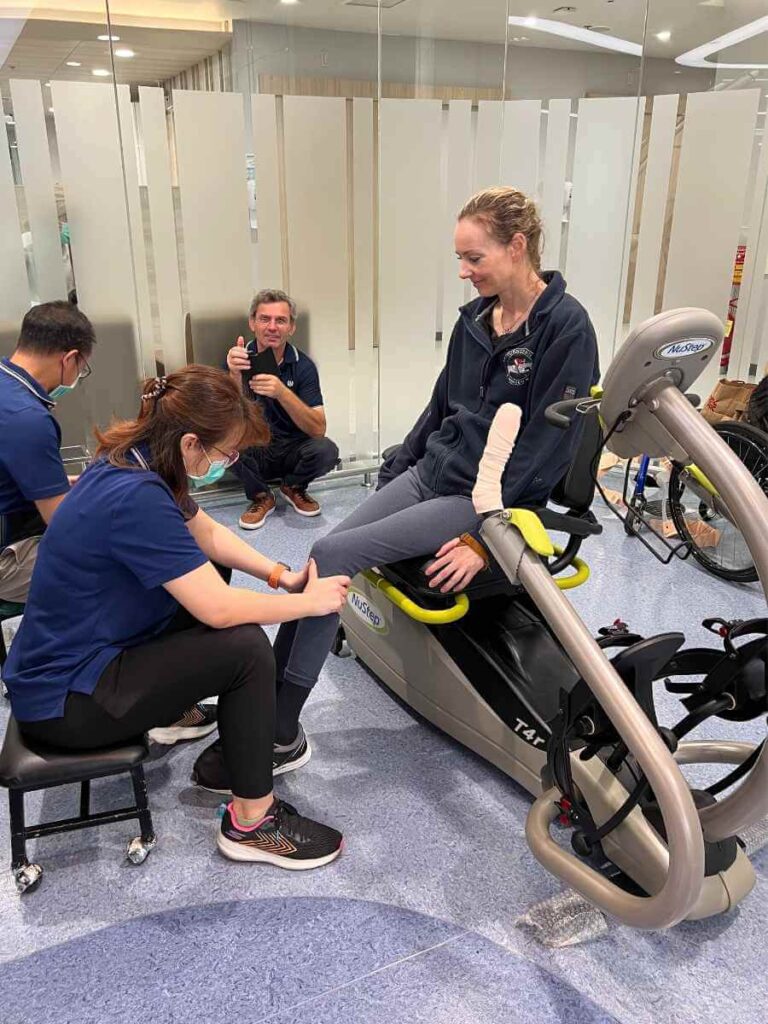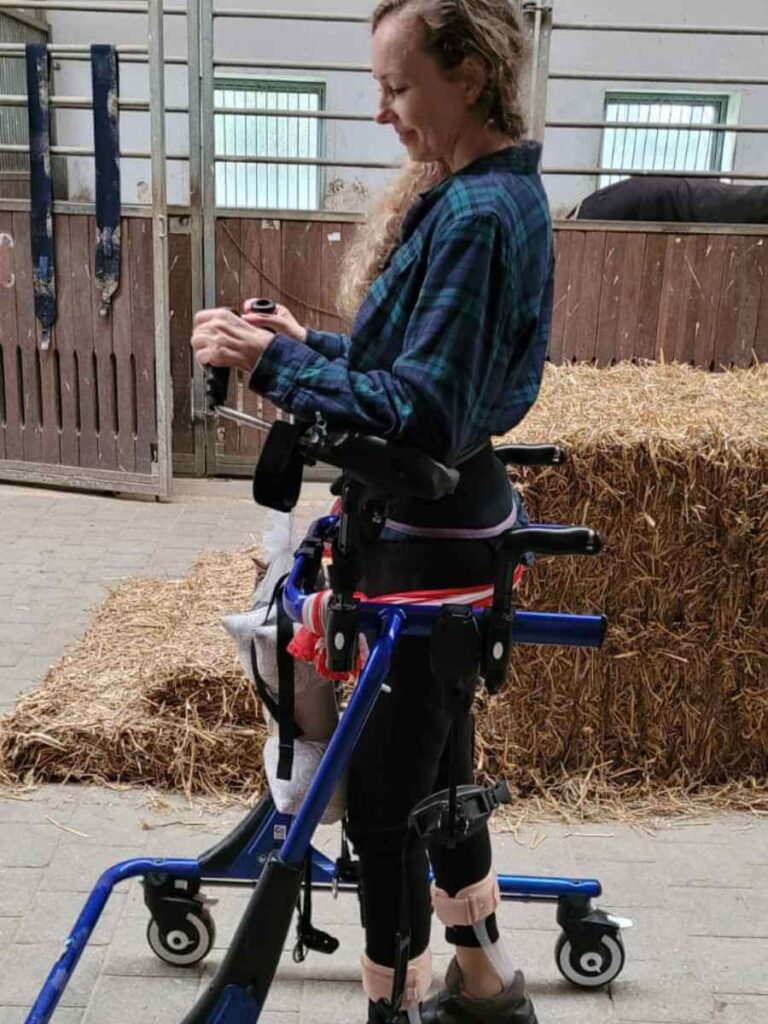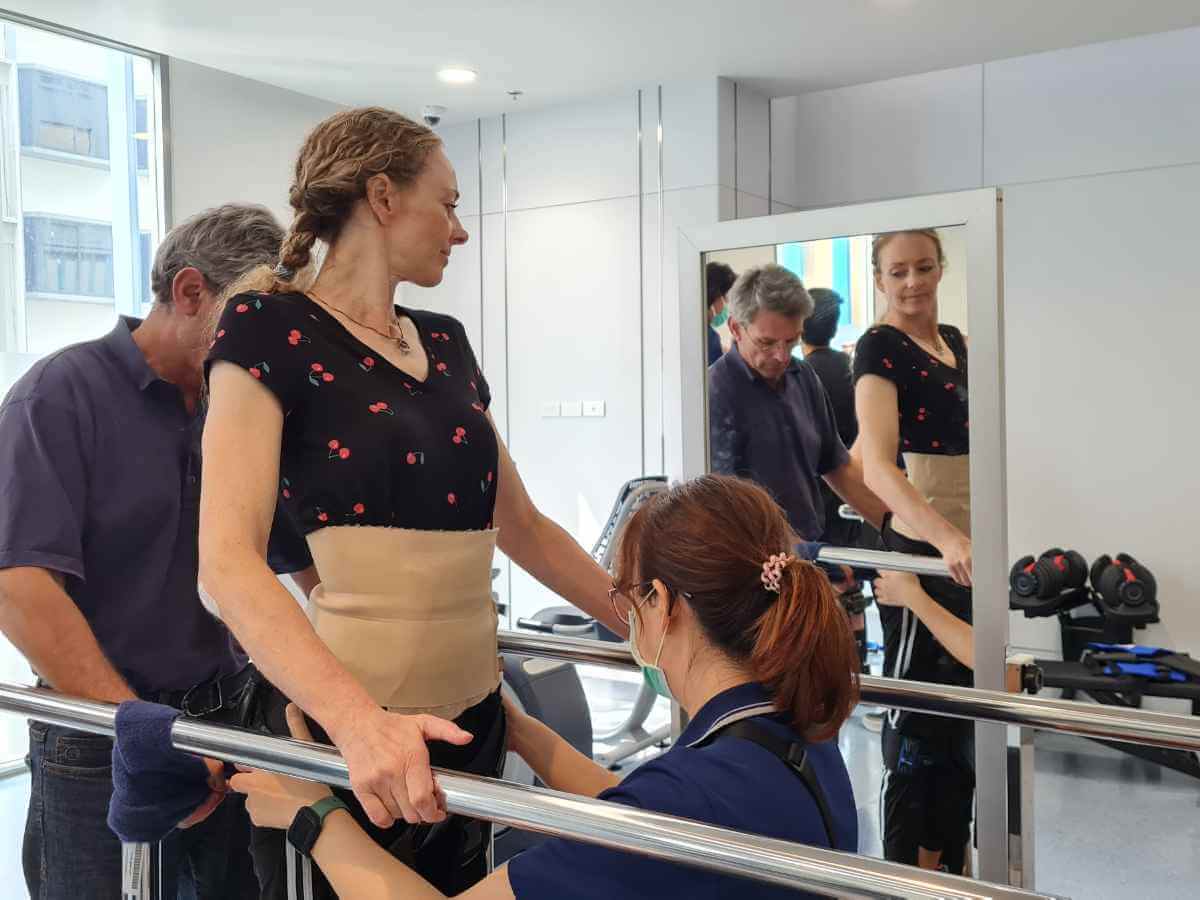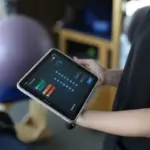Following a horse riding accident which left her with an incomplete C6-C7 level spinal cord injury (SCI), Alison Leclerc was looking for treatment. After doing a lot of research, Alison realised she didn’t want to wait for the results of SCI clinical trials to be able to begin taking steps to recover. That’s when she got in touch with Verita Neuro, to begin our epidural stimulation treatment program. In this interview, with Patient Representative Vea Gaygon, Alison shared her experiences of the treatment and some of the improvements she has seen.
Please can you introduce yourself?
Sure, my name is Alison and I have a spinal cord injury, C6-C7 level. From what I understand it's more at the C6 level. It was a compression injury. So my C7 vertebra moved out of place and into the C6 area of the spinal cord. But both were involved. It's an incomplete injury, but mostly the incompleteness is sensory. The short version of how I was injured is that I had a fall from a horse, so it was a riding accident. The horse went up because of something going on outside. She went up on her back legs, and I got hit in the face. I lost consciousness, and slid down the horse and since I was not conscious, I didn’t really have any control of my body, and I just slid off.
How did you learn about epidural stimulation?
Well, I do a lot of research online and of course I look at SCI clinical trials studies, potential treatments, cures - I know there is no cure, but I look for possible treatments, and something I can do. So I found it online, and I had seen it quite early on in my injury. But at that time I wasn't really keen on getting a medically implanted device and I wanted to try to recover as much as possible naturally. But with a SCI, you'll get to a certain point, and you hit a plateau and you don't really go beyond that plateau, or at least it's difficult. So that's when I saw, I think it was in a Facebook group, someone who had been here posted some videos, and it made me think ‘Ok, well, why not? I've come so far and I'm not really making any more progress - why not? Why not try it?’. I reached out to her, and she was kind enough to take the time to speak with me and I saw a lot of the testimonials and videos from other people online so I thought, ‘Okay, well this seems promising. Why not give it a try?’. So I had the device implanted at the end of September 2022 and I do as much as I can. I think the more you use the device and the more you do with it, the better the results are.
What were your impressions of the team?
Oh, yeah, everyone is wonderful. Excellent. I mean, the therapists are all really, really good. They're super specialized in spinal cord injury. The whole mapping process with the stimulator, this is quite a complex process, but they're really, really good at what they do. This is true for the whole staff, I mean, the medical staff were excellent too. They were really attentive, always there, they supported me and everything was really well organized. We basically arrived and everything was planned out for us, so that made it really easy.
I’m very happy to hear that! So, what were your expectations prior to undergoing this surgery?
I guess I try not to set my expectations too high, you know, because I don't want to set myself up for disappointment. So I guess that I didn't really have any! Of course, you want to see improvements, I guess I just would rather I set the bar a little lower instead of setting it high and not reaching that. I hope to be able to stand and take steps and move my legs with the stimulation. But you never know so honestly, I didn't really know what to expect 100%.
Do you have a favorite exercise? And what do you like most about being here?
Oh, yeah, it's stepping, for sure. It just feels really good to be upright, vertical and taking steps like before. Ok, not exactly like before, but that's definitely my favorite exercise.
I like the way that everything is structured. I think that it's what we do, the exercises we do. The way it's structured is really good. The people, the therapists and the staff are excellent - really good and everything is really well organized. I really liked the breakfast buffet at the hotel as well. The hotel is good and so is the hospital. In the hospital we had a big room, the room was large and very accessible. The nursing staff were really good and we had a nice view of a temple. The hotel is also very good. I think this is a five star hotel, so the accommodations are great. The hotel is also really accessible, the bathroom is very good and very spacious. It's easy to go around everywhere in your wheelchair.
I like the way that everything is structured. I think that it's what we do, the exercises we do. The way it's structured is really good. The people, the therapists and the staff are excellent - really good and everything is really well organized. I really liked the breakfast buffet at the hotel as well. The hotel is good and so is the hospital. In the hospital we had a big room, the room was large and very accessible. The nursing staff were really good and we had a nice view of a temple. The hotel is also very good. I think this is a five star hotel, so the accommodations are great. The hotel is also really accessible, the bathroom is very good and very spacious. It's easy to go around everywhere in your wheelchair.
If you had to name three things that have changed the most, what would they be?
Three things. Only three!?
Ok, well, the ability to move your legs with the stimulation on. Without it, I can't move my legs. In my latest session, we found some really good programs for stepping and standing, so now I can lock out both my legs to be able to stand. I have to go home and keep on working on it and practice and everything.
With my left leg I can take a normal step - you know, pick the leg up, put it down and then lock it to stand. I don't have it on the right side yet, but it's basically a normal step, like a normal person would step so that’s definitely pretty cool.
My blood pressure is definitely better. Without the stimulation, I've had definite improvements in my blood pressure. I haven't really tested this out yet because I live in a cold climate, but I know last time I was here in Bangkok, I was starting to sweat on my head, neck and chest and I hadn’t done that since before my injury. I have to see when it's hot if I start sweating in more places.
Ok, well, the ability to move your legs with the stimulation on. Without it, I can't move my legs. In my latest session, we found some really good programs for stepping and standing, so now I can lock out both my legs to be able to stand. I have to go home and keep on working on it and practice and everything.
With my left leg I can take a normal step - you know, pick the leg up, put it down and then lock it to stand. I don't have it on the right side yet, but it's basically a normal step, like a normal person would step so that’s definitely pretty cool.
My blood pressure is definitely better. Without the stimulation, I've had definite improvements in my blood pressure. I haven't really tested this out yet because I live in a cold climate, but I know last time I was here in Bangkok, I was starting to sweat on my head, neck and chest and I hadn’t done that since before my injury. I have to see when it's hot if I start sweating in more places.

How is the medical care different from healthcare at home?
The surgeon who performed the operation was really, really good. After the surgery, he came to check up on me - at home, the surgeon would never come to your hospital. But he was the one who took my staples out, after the surgery. At home, the surgeon would not do this job and after the surgery, I saw him several times again and he was interested in how I was doing and my recovery thus far. After I had the operation, Dr. Nasir, and everyone kept an eye on, you know, my wound and how I was, making sure that everything looked good. Everyone was really attentive and they deliver really good care. When you’re in the hospital, if you need something, the nursing staff are there right away. They were really quick and really attentive.
And what about your therapists?
Well, I had my primary therapist and I worked with a few of the others. Often, there will be another therapist assisting your primary therapist, so I worked with a lot of them and they’re all really good. One other really good thing is the spasticity program that I use every night. It takes away spasms so that I don't have to take spasm medication anymore. This is a really good feature.
What does a regular day here look like?
There's a lot that goes into it and you have to use the stimulation a lot - you have to train with it. I was here for 7 weeks. I came back at the end of February for a couple of weeks and I could already see there was a big difference and there was a lot of progress since then. You have to train with it a lot and then I think you set yourself up for getting better results. We train a lot, every day. When I'm here, we wake up at 6 in the morning, get ready, and go down to have the wonderful breakfast here at the hotel. Then we get picked up and we're at the center at nine for two hours of mapping, then one hour PT, an hour lunch break, and then two hours of mapping again. So that's five hours of doing therapy exercises and mapping in a day. I think that's what is necessary - you have to keep that up to or try to when you go home. It's intensive therapy every single day with the stimulation, but then also a little bit without. It’s hard work everyday, yes, but it's worth it.
So how soon after the surgery, did you start to see changes?
The first time they switch it on, you start to try moving your legs and it’s quick! Maybe two or three days after the surgery, we started the mapping process, and when you start to be able to move your legs again, you’re trying to figure things out so quickly and it moves quite quickly. There's a lot of exploration within the whole mapping process, and trying to figure out different programs that get certain results. It’s lengthy and requires a lot of patience, but you start to see effects quite quickly after the surgery.
So, the question is, was epidural stimulation worth it, and if so, why?
Absolutely, yes, yes. Absolutely. I think it does give you hope. I’ve tried all different kinds of therapies. Right after my injury, I did improve, because I was also doing rehabilitation and therapy, so I did improve up to a certain point. Once I reached that point, I continued, and I tried osteopathy - exoskeletons. You name it, I've probably tried it. But nothing was really bringing me further with my progress. I have improved a lot since doing this so it's something that I know if I keep working with it, I'll improve more. So it really does give you hope and then, when you see the improvements, that kind of fuels it more and more.
And what will you do when you go home?
I mean, we live in Southern Germany and there are not a lot of neuro recovery centers, or centers that are specialized. I still go once a week to a therapist and I have a therapist who comes to the house once a week but only for an hour, which is not enough. I need to do way more than that. We have a lot of equipment at home - parallel bars, e-Pacer and this walker which I used here. We found a used one online, on eBay, so I bought one of those. So we have some equipment that we can use at home. Me and my husband are always trying to think of a new exercise or a new way of trying something. But I am fortunate that I have this equipment at home.

Do you have a message for anyone else wanting to learn about the treatment?
Yeah, it's definitely worth it, if you have the opportunity to do it, it's definitely worth trying. I can only speak for myself, but I don't want to sit around and wait for a cure. I know there are some promising SCI clinical trials and things that are just around the corner but I don't want to wait for that. You never know how many years this will take so if you have the opportunity to do something, or try something, why not? Try anything and everything you can! I know it's not for the faint of heart, but SCI is a really difficult injury and I think you have to be open minded and try anything and everything.
The above is not a verbatim transcript of Alison’s interview. Some comments have been slightly altered or re-arranged in order to improve the reading flow. If you would like to hear the full webinar, you can visit our YouTube channel.





